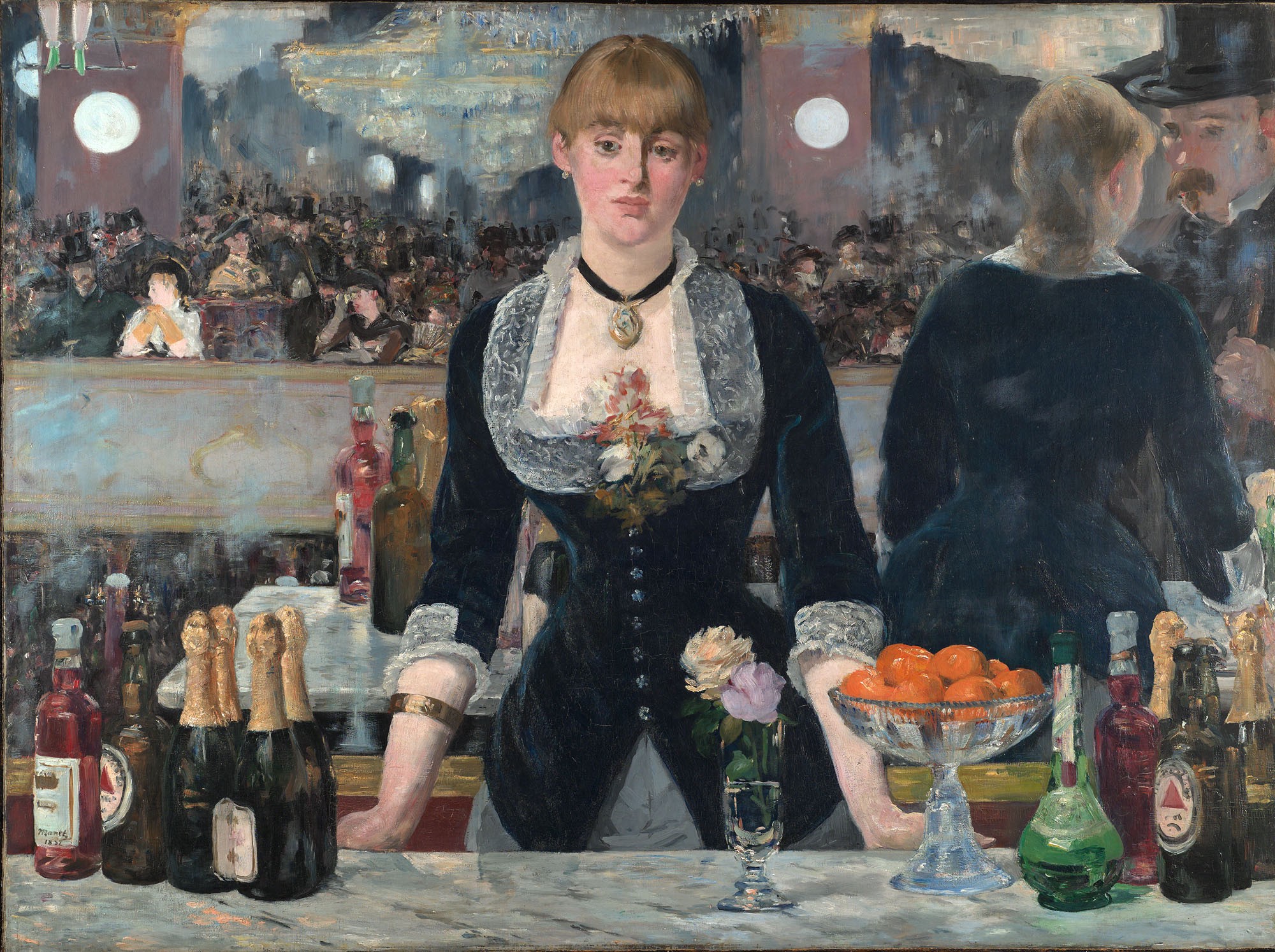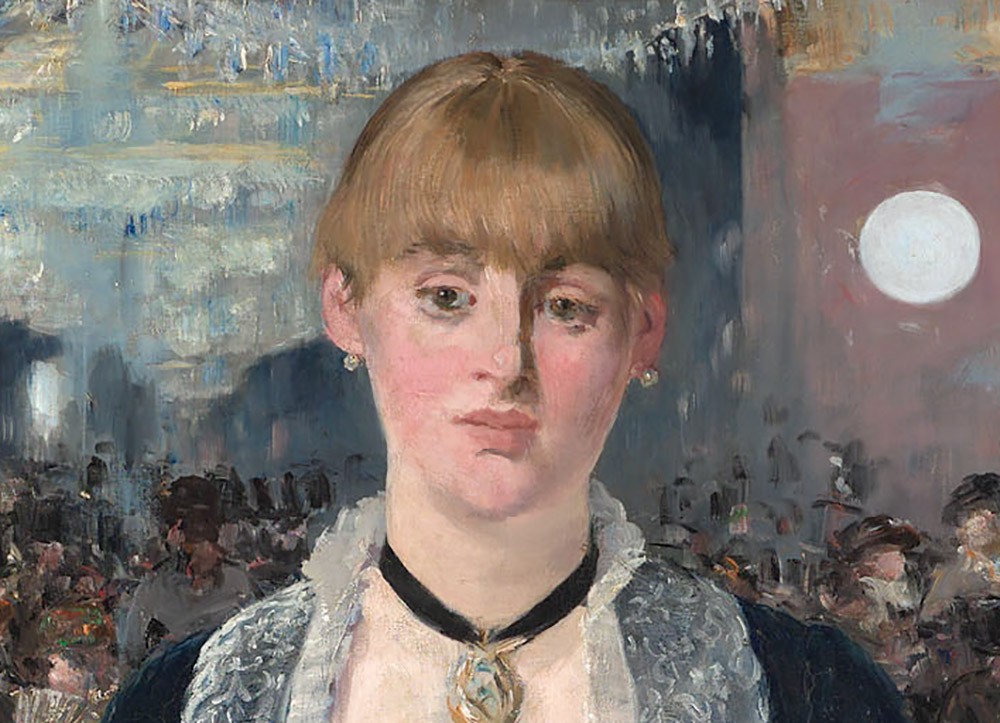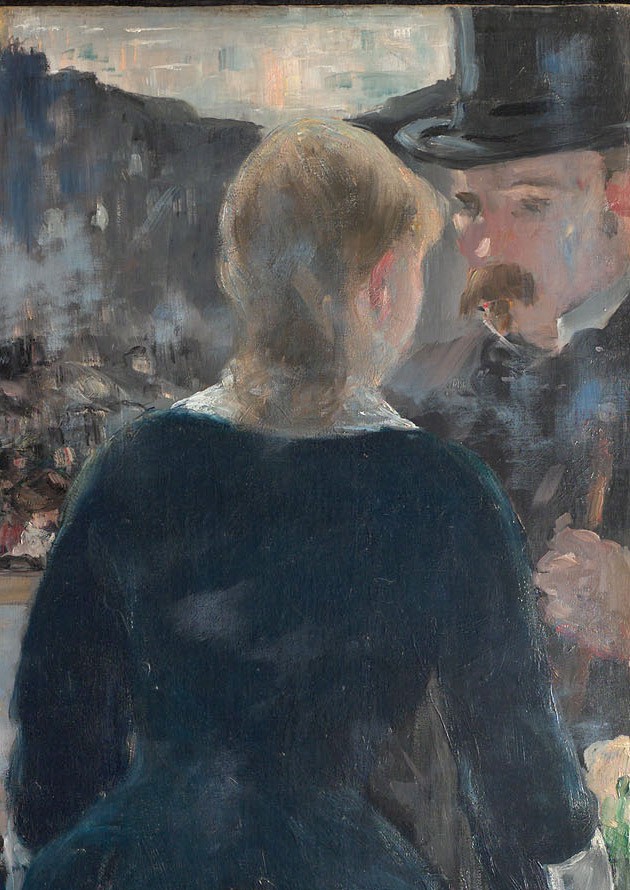A compelling work of art that continues to yield new readings
 A Bar at the Folies-Bergre (1881?1882) by douard Manet. Courtauld Institute of Art, London. Source Wikimedia Commons
A Bar at the Folies-Bergre (1881?1882) by douard Manet. Courtauld Institute of Art, London. Source Wikimedia Commons
douard Manet completed A Bar at the Folies-Bergre in 1882, just a year before he died ? of syphilis at the age of 51. It shows a counter in a busy entertainment venue where a barmaid has come to serve a patron.
The social setting is one of modern urban exchange; we are in the territory of a familiar and public world, of the coded transactions of amusement and high-society. Manet?s brilliance is that he leaves the image open to perpetual questioning. The barmaid, for instance, maintains an ambiguous demeanor somewhere between assertiveness and disenchantment. She stands and meets our gaze, yet also draws away from our gaze too. Such ambiguities, along with the bold composition and quickly applied brushwork, keep the work fresh, even a century-and-a-half after it was made.
There is one detail of this painting that is easy to miss, though perhaps one of the most telling. It appears in the top left-hand corner: a pair of legs with green shoes belonging to a trapeze artist performing above the audience. The legs of the trapeze act indicate that the evening?s performance is in full flow. For me, the trapeze artist gives the work an energy: the sense of a lively, raucous evening at full tilt.
The Folies-Bergre was (and still is) a cabaret music hall located in Paris just a little south of Montmartre. It first opened its doors in 1869 as a modern pleasure venue where a typical show might include ballet, pantomime, acrobatics, operetta and animal acts.
At the Folies-Bergre, guests were invited to sit where they pleased or to move around the ?promenade? walkway which was lined with bars and couches. The novelist and art critic Joris Karl Huysmans wrote a contemporary account of the Folies-Bergre: ?It is ugly and it is superb, it is of an outrageous yet exquisite taste; […] its walks covered with tables, rattan couches, chairs and counters staffed with fiercely rouged women, resembles at the same time the rush of the Rue Montesquieu and an Algerian or Turkish bazaar.?
 Detail of A Bar at the Folies-Bergre (1881?1882) by douard Manet. Courtauld Institute of Art, London. Source Wikimedia Commons
Detail of A Bar at the Folies-Bergre (1881?1882) by douard Manet. Courtauld Institute of Art, London. Source Wikimedia Commons
Manet?s painting shows us one of the bars along the promenade. There is a marble counter with bottles of champagne, wine and beer. A barmaid stands to serve us, in attendance yet clearly distracted, since her eyes avert to the left and her expression is cool, or perhaps weary, depending on how you read it.
The view we see of the cabaret is via a mirror behind the barmaid. You can see her reflection to the right of the painting: she is talking to a man in a top hat and moustache.
 Detail of A Bar at the Folies-Bergre (1881?1882) by douard Manet. Courtauld Institute of Art, London. Source Wikimedia Commons
Detail of A Bar at the Folies-Bergre (1881?1882) by douard Manet. Courtauld Institute of Art, London. Source Wikimedia Commons
The dynamics of the mirror reflection have been the cause of much discussion around this painting. It has been argued that the barmaid?s reflection is too far off the right, that objects along the counter are illogically displaced, and that the man in front of her in the reflection isn?t actually there in ?reality?.
One scholar has sought to find a solution to the visual inconsistencies of the painting, with apparent success. Either way, it is clear that Manet has used the mirror to show us the world that the barmaid is looking out onto. In doing so, he is giving her a vantage point; it is an ingenious way of enabling her a perspective whilst keeping her the subject of the painting.
Moreover, in the history of art, a mirror is one emblem of Vanitas. A ?vanitas? painting is a symbolic work of art expressing the transience of life, the futility of pleasure, and the certainty of death. The suggestion is that is that we are the customer, approaching the bar for a drink, seeing the world from which we have emerged reflected back in the mirror. It is a world of pleasure certainly, and perhaps of folly too.
In such a way, the reflection disrupts and plays with the invocation of the flneur, an idealized figure presiding over the spectacle of city life. Interpretations of the painting suggest that the bowl of oranges on the counter symbolize that the barmaid was also a prostitute. As the art historian T.J. Clark says, the barmaid is ?intended to represent one of the prostitutes for which the Folies-Bergre was well-known?, who is represented ?as both a salesperson and a commodity ? something to be purchased along with a drink.? The encounter depicted in the painting participates in the commercial or sexual exchange commonplace in 19th century Paris, yet as the presence of the mirror makes clear, the transaction is one fraught with moral problems.
Manet?s work defies an easy reading because it relinquishes any easy or moralistic judgements on the barmaid. Looking back now, we tend to celebrate Manet?s approach to art as a challenge to convention, but to his contemporaries his paintings had a directness about them that (for some) lacked dignity and refinement, exacerbated by the flat brushwork and the loose handling of paint. The painting is equivocal and self-aware ? all attributes which we would now designate as ?modern?.
The ?abruptness of nature? ? as Emile Zola once remarked about Manet?s style ? is the result of close study and an inquisitive eye. And this is the remarkable quality of douard Manet: how his oil paintings capture the interplay of perceptions of his subjects ? the looks and glances, the way people stand and gaze ? and makes it seem like it?s happening right in front of you. A Bar at the Folies-Bergre gives us a glimpse into a complex social setting, painted with all the ambivalence and apprehension the encounter justifies.
 A Bar at the Folies-Bergre (1881?1882) by douard Manet. Courtauld Institute of Art, London. Source Wikimedia Commons
A Bar at the Folies-Bergre (1881?1882) by douard Manet. Courtauld Institute of Art, London. Source Wikimedia Commons
Christopher P Jones writes about culture, art and life at his website. Sign up for more.


